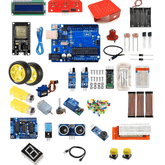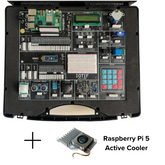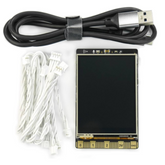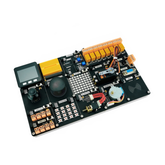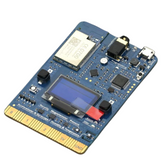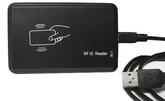RFID and IoT Similarities, differences and applications
Summary
Unlocking the Power of RFID and IoT: Exploring Similarities, Differences, and Applications" dives deep into the realms of Internet of Things (IoT) and Radio-Frequency Identification (RFID) technologies.
Beginning with an introduction to both concepts, the blog elucidates the intricacies of IoT and RFID, highlighting their components and operational mechanisms. Delving into their relationship, it explores how RFID contributes to IoT solutions, emphasizing its pivotal role.
Additionally, the piece sheds light on considerations for selecting RFID IoT solutions, while outlining their advantages, challenges, and real-world applications. Don't miss out on discovering the synergy between RFID and IoT for your business's transformative journey!
What is IoT?
The Internet of Things, or IoT for short, is an innovation in modern technology. IoT represents the integration of actual objects, from everyday items to high-tech cars, improved by a set of innovative components: software, sensors, and networking.
All of these entities can now easily link to one another thanks to this combination, creating a dynamic ecosystem in which they can cooperate and share data.
Practically speaking, IoT makes it easier for a wide range of devices to seamlessly gather and share data.

These things' ability to speak with one another and with their surroundings is made possible by their interconnection.
Consequently, IoT creates an endless number of chances for the creation of automated and more effective systems in a variety of fields.
What is RFID and How Does it Work?
RFID, or radio frequency identification, is a wireless communication technology that uses electromagnetic or electrostatic coupling within the radio frequency range to uniquely identify objects, animals, or individuals.
An RFID system is basically made up of three parts: a transceiver, a transponder, and a scanning antenna.
The combination of the transceiver and scanning antenna creates an RFID reader or interrogator. There are two varieties of these readers: mobile readers and fixed readers.
A fixed reader is a network-connected device that can be fixed permanently or made portable. To activate RFID tags, it releases radio waves.
Upon activation, the tag responds with its distinct data, which the antenna then records and the reader decodes.

The most important component of the RFID system is the transponder, which exists within the RFID tag.
The type of tag, reader, frequency, and interference from the surroundings can all affect an RFID tag's read range. Generally, tags with a more powerful power source have a longer read range.
Components of RFID
- RFID Tag: Consists of an antenna, substrate, and integrated circuit. There are two types such as passive (without a power source) and active (with one).

- RFID Reader: Obtains information about items by reading tags. Using Bluetooth and USB technologies, it can be either wired or wireless.

- RFID software: It serves as data sharing and management software by tracking and monitoring tagged things.

Relation between RFID and IoT
- RFID technology serves as a foundational element within the broader architecture of IoT.
- Integration of RFID tags into everyday products provides ambient intelligence, enabling identification and monitoring through connected computing devices.
- RFID technology allows certain communication protocols to send RF signals to devices that are compatible with them.
- The foundation of the Internet of Things is RFID technology, which makes it easier to integrate assets and things into the network.
- Through the use of passive RFID tags, a variety of things can be connected to the internet and communicate and interact with one another inside the Internet of Things.

How do RFID IoT Solutions work?
RFID (radio frequency identification) and IoT (Internet of Things) are two powerful technologies that come together to form RFID IoT solutions.
These solutions have a lot to offer enterprises that track inventories, manage supply chains, and keep an eye on assets. RFID technology uses tags that are attached to the things to communicate wirelessly and through electromagnetic fields.
By sending information to RFID scanners, these tags make it easier to identify and follow objects as they travel.
On the other hand, Internet of Things (IoT) technology combines a variety of networked smart devices and software to facilitate smooth communication, real-time control, and monitoring throughout a network.
Businesses benefit from increased supply chain visibility, greater asset tracking capabilities, and improved product tracing features when RFID and IoT are combined.
This integration allows for a more comprehensive understanding of the movement and status of goods and assets within the ecosystem.
RFID IoT solutions are becoming more and more popular among companies looking to optimize their operations because of their effectiveness and efficiency.
Businesses may minimize errors, optimize workflows, and ultimately cut expenses and save time by utilizing these solutions.
For businesses in a variety of industries, this means more production and more chances to generate income.
Role of RFID for IoT
- RFID technology is a fundamental component of IoT, with the Savant system and the Internet contributing greatly to its development.
- RFID tags, which allow items to communicate with the central IoT hub, are the primary method by which RFID technology is applied in the Internet of Things.
- RFID tags are fundamental components of Internet of Things systems that enable status reporting and communication between linked items.
- The incorporation of RFID technology into the Internet of Things facilitates improved monitoring, tracking, and decision-making procedures across several industries and applications.
- By serving as a conduit, RFID technology connects tangible objects to the Internet of Things (IoT) network, enabling smooth data generation and transmission.
Things to Consider While Choosing RFID IoT Solution for Your Business:

- Ensure the solution meets your objectives, such as inventory management or supply chain optimization.
- Assess installation ease, maintenance, power, and resource requirements.
- Prioritize data security, privacy, and adherence to regulations.
- Confirm the solution can grow with your business needs.
- Check compatibility with existing systems.
- Evaluate costs versus benefits.
- Choose a reliable provider with good support.
- Opt for an intuitive system to enhance adoption.
- Seek customizable options.
- Select a provider committed to ongoing updates and innovation.
Advantages of RFID in IoT

- Security: Information stored on RFID systems is usually protected and can only be accessed with specific equipment. This improves security in general, especially for lock systems
- Ease of Use: RFID keys provide quick and easy access to security systems by simply using a proximity gesture to open them.
- Smaller Size: Because RFID cards are compact and approximate conventional bank cards in size, they are easier to keep and are less likely to be forgotten when access is required.
- Flexibility: A wide range of doors and furnishings can be used with RFID locks because they come with many options for spin and cam lengths. They can be used for a variety of commercial and application demands because of their flexibility.
- Master Card Functionality: Rather than requiring several cards, an RFID key card can be used to program different kinds of locks. This keeps separate access policies for every lock and streamlines access management.
- Efficiency: RFID technology streamlines procedures and minimizes user involvement by enabling quick, automated asset or object tracking and identification.
- Real-time Monitoring: Businesses may obtain real-time data regarding the location and status of tagged products with RFID linked into IoT systems, facilitating proactive resource management and better decision-making.
Challenges and Limitations of RFID in IoT
- While there are many benefits to RFID technology, there are also some drawbacks to take into account. Among the main drawbacks of RFID use are:
- RFID reader performance can be hampered by physical obstacles, particularly when dealing with metallic objects.
- Poor security protocols may result in unauthorized entry to private information kept on RFID tags.
- The adoption of RFID technologies may be hampered by their higher cost compared to standard barcode systems.
- Large-scale data generation can be difficult to handle and process in terms of storage, analysis, and interpretation.
- Because of their usually short read range, RFID tags may not be as useful in other situations.
Applications of RFID in IoT
- Monitor tools, equipment, and inventory in real-time.
- Regulate access to facilities and restricted areas.
- Monitor employee, visitor, and delivery times.
- Track vehicles for fleet management and security.
- \Monitor product movement through the supply chain.
- Track shipping containers for supply chain management.
Conclusion
In the Internet of Things, RFID technology is essential for smooth object tracking and communication. The incorporation of RFID technology into the Internet of Things (IoT) presents notable advantages for enterprises, including better asset tracking and supply chain management, despite obstacles like as restricted coverage and security issues.
Scalability and data security are important considerations for firms investigating RFID IoT solutions in order to maximize the technology's potential for development and efficiency.



